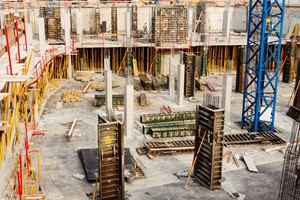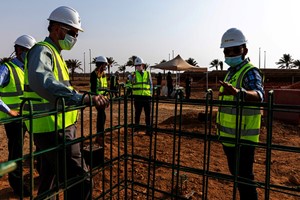The construction industry is experiencing a gradual transformation driven by technological advancements, despite its traditional reliance on human labor. In Romania, this shift is notably illustrated by Kesz Romania, a leading construction firm undertaking the ambitious project of establishing a new AI Research Institute at the Technical University of Cluj-Napoca.
Last year, Kesz Romania reported substantial business growth, with revenues reaching nearly 300 million RON. They are now engaged in a prestigious new venture, having secured a contract worth over 105 million RON through a public tender. Although one might expect a construction site for an Artificial Intelligence Institute to be equipped with cutting-edge technologies, it primarily utilizes standard construction machinery.
Nevertheless, the site is not devoid of innovation. Kesz Romania is employing an advanced methodology known as 6D Building Information Modeling (BIM). This approach involves comprehensive digital representations of the project's characteristics, facilitating the management of time, budget, and environmental impact to achieve a 'green building' certification. The director of Kesz underscores the importance of BIM for planning and cost management throughout the construction process.
The future AI center is envisioned as an open learning environment for engineering students, architects, and professors, promoting practical, hands-on education. Kesz is committed to integrating the academic community into the project, highlighting the value of pragmatic learning in an increasingly digital age.
The Romanian construction market is poised for a transformation, with an anticipated shift towards prefabricated components and increased automation. While labor shortages have been a significant challenge in the construction sector, Kesz Romania sustains a robust workforce by fostering fair partnerships with subcontractors.
Despite the slow integration of digital technology within the industry, as observed by McKinsey consultants, there is a strong belief that a digital revolution in construction is imminent. The potential of 3D printing, among other innovations, promises to enhance efficiency and productivity, potentially redefining the industry's future.
The Rise of AI in Romania’s Construction Industry: Key Questions and Answers
What is the significance of the AI Research Institute project in Romania?
The AI Research Institute project at the Technical University of Cluj-Napoca represents a significant advancement for Romania's construction industry. It serves as an educational hub for students and professionals to engage with practical, digital technologies. Its construction highlights the potential for integrating advanced methodologies like 6D BIM into traditional industries.
What challenges does the Romanian construction sector face in adopting AI and other digital technologies?
A primary challenge is the industry's slow pace of digital integration. Existing workflows and a reliance on manual labor have impeded the adoption of new technologies. Additionally, there is a need for investment in training and development to equip the workforce with the necessary digital skills.
Are there any controversies related to AI in construction?
Debates within the industry may arise over job displacement due to increased automation. Concerns also exist regarding data privacy and security when employing AI and digital technologies in construction projects.
Advantages and Disadvantages of AI in Romania’s Construction Industry
Advantages:
- Enhanced efficiency: AI can optimize construction processes, reducing time and costs.
- Improved planning and management: Tools like 6D BIM enable better planning, cost management, and sustainability practices.
- Addressing labor shortages: Automation can mitigate the impact of labor shortages in the construction industry.
- Innovation and competitiveness: Incorporating AI can drive innovation, leading to more competitive businesses.
Disadvantages:
- Initial investment costs: Implementing AI solutions requires significant upfront investment.
- Workforce disruption: The transition to digital methods may displace workers who lack the necessary skills.
- Data security concerns: Increased digitization could lead to risks associated with data breaches and cybersecurity.
- Resistance to change: Cultural resistance within the industry may slow down the adoption of new technologies.
The implementation of AI in Romania’s construction industry offers substantial benefits in terms of efficiency and innovation. However, the challenges of cost, workforce transitions, and cultural resistance must be addressed to fully realize its potential. The future AI center at the Technical University of Cluj-Napoca symbolizes a commitment to integrating modern technology in the field and preparing the next generation of construction professionals for a digital future.











